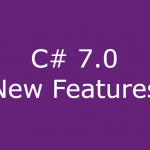Numeric Literals and Binary Literals in C# 7.0
Numeric Literals
When working with literals of a numeric type having large and complex number will be hard to read. For example, if we are assigning a large integer to say one million I.e.., 1000000 tailing 6 zeros to 1. Now if you see this number it will be very hard to read and the user should count the zero’s to know it a one million.
To solve this readable issue, a Literal (_) is now allowed in between the integer number to divide the digits from C# 7.0. Now, let’s see in practical implementation to understand this new feature.
Following is the implementation lines using C# 6.0
int cSharp6IntDemo = 100000; double cSharp6DoubleDemo = 12.45; Console.WriteLine(cSharp6IntDemo); //output: 100000 Console.WriteLine(cSharp6DoubleDemo); //output: 12.45
Now, the same can be written in C# 7.0 by introducing this literal for better readable.
int cSharp7IntDemo = 1_00_000; double cSharp7DoubleDemo = 1_2_3.45_00; Console.WriteLine(cSharp7IntDemo); //output: 100000 Console.WriteLine(cSharp7DoubleDemo); //output: 123.4500
As you can observe in the above line of codes, we using literal (_) to separate the digits.
Binary Literals
In C# 6.0, if you want to initialize a binary literal need to use hexadecimal notation as follows,
int hexFifteen = 0xF; int hexTwoFiftyFive = 0xFF; Console.WriteLine(hexFifteen); //output: 15 Console.WriteLine(hexTwoFiftyFive); //output: 255
It is hard to decode hexadecimal notations. To solve this problem now from C# 7.0, you can use the binary bit literals itself by prefixing with ‘0b’ as follows.
int bitFifteen = 0b1111; int bitTwoFiftyFive = 0b1111_1111; Console.WriteLine(bitFifteen); //output: 15 Console.WriteLine(bitTwoFiftyFive); //output: 255
Hope you understand this feature introduced from C# 7.0.
You can see complete code here in GitHub
Happy Coding 🙂

